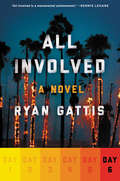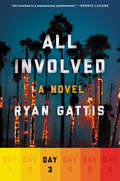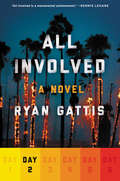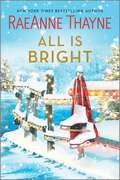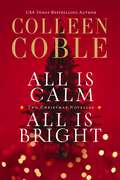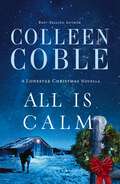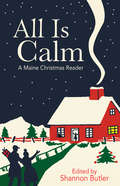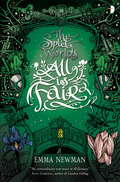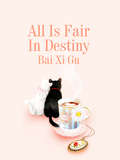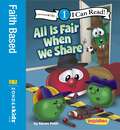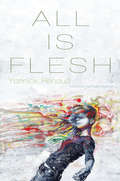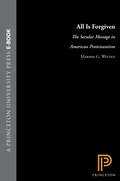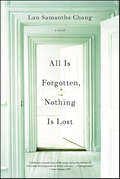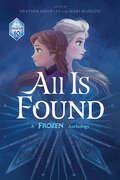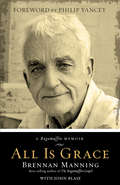- Table View
- List View
All Involved: Day Six
by Ryan GattisAll Involved can either be read as a full-length eBook or in 6 serialized eBook-only parts.This is part 6 of 6, or DAY 6 of 6 days.At 3:15pm on April 29, 1991, a jury acquitted three white Los Angeles Police Department officers charged with using excessive force to subdue a black man named Rodney King, and failed to reach a verdict on the same charges involving a fourth officer. Less than two hours later, the city exploded in violence that lasted six days.A gritty and cinematic work of fiction, All Involved vividly re-creates this turbulent and terrifying time, through seventeen interconnected first-person narratives set in the wake of one of the most notorious and incendiary trials of the 1990s.edia during the riots. Ryan Gattis tells seventeen interconnected first-person narratives that paint a portrait of modern America itself--laying bare our history, our prejudices, and our complexities. With characters that capture the voices of gang members, firefighters, graffiti kids, and nurses caught up in these extraordinary circumstances, All Involved is a literary tour de force that catapults this edgy writer into the ranks of such legendary talents as Dennis Lehane and George V. Higgins.
All Involved: Day Three
by Ryan GattisAll Involved can either be read as a full-length eBook or in 6 serialized eBook-only parts.This is part 3 of 6, or DAY 3 of 6 days.At 3:15pm on April 29, 1991, a jury acquitted three white Los Angeles Police Department officers charged with using excessive force to subdue a black man named Rodney King, and failed to reach a verdict on the same charges involving a fourth officer. Less than two hours later, the city exploded in violence that lasted six days.A gritty and cinematic work of fiction, All Involved vividly re-creates this turbulent and terrifying time, through seventeen interconnected first-person narratives set in the wake of one of the most notorious and incendiary trials of the 1990s.edia during the riots. Ryan Gattis tells seventeen interconnected first-person narratives that paint a portrait of modern America itself--laying bare our history, our prejudices, and our complexities. With characters that capture the voices of gang members, firefighters, graffiti kids, and nurses caught up in these extraordinary circumstances, All Involved is a literary tour de force that catapults this edgy writer into the ranks of such legendary talents as Dennis Lehane and George V. Higgins.
All Involved: Day Two
by Ryan GattisAll Involved can either be read as a full-length eBook or in 6 serialized eBook-only parts.This is part 2 of 6, or DAY 2 of 6 days.At 3:15pm on April 29, 1991, a jury acquitted three white Los Angeles Police Department officers charged with using excessive force to subdue a black man named Rodney King, and failed to reach a verdict on the same charges involving a fourth officer. Less than two hours later, the city exploded in violence that lasted six days.A gritty and cinematic work of fiction, All Involved vividly re-creates this turbulent and terrifying time, through seventeen interconnected first-person narratives set in the wake of one of the most notorious and incendiary trials of the 1990s.edia during the riots. Ryan Gattis tells seventeen interconnected first-person narratives that paint a portrait of modern America itself--laying bare our history, our prejudices, and our complexities. With characters that capture the voices of gang members, firefighters, graffiti kids, and nurses caught up in these extraordinary circumstances, All Involved is a literary tour de force that catapults this edgy writer into the ranks of such legendary talents as Dennis Lehane and George V. Higgins.
All Is Beauty Now
by Sarah FaberIn the aftermath of the mysterious disappearance of their eldest daughter, a once-golden family prepares to leave behind the seeming paradise of Brazil for the safer, more pragmatic shores of Canada. But as the family counts down the days to their departure, secrets and betrayals surface, threatening their hopes for a new life.Brazil, 1962: A young woman walks into the waters off a crowded beach and vanishes. A year later, her family - the once-golden family of their privileged little community - prepares to leave behind the seeming paradise of Brazil in the wake of their eldest daughter's presumed drowning. As they attend a series of goodbye parties and count down the days to their departure, we are taken into the heart of a family whose many charms belie more troubling truths. There is the family's charismatic father, whose emotional extremes are becoming increasingly disturbing; his long-suffering wife, who made a mistake that has shattering consequences for the family she meant to protect; and their two remaining daughters, both on the precipice of joining the adult world with all its secrets and lies. Then there is the lost daughter herself, a woman undone by her attempts to grasp at happiness. With settings ranging from the opulence of the legendary Copacabana Club to the poverty of Rio's fishing villages, this sensual and beautifully written novel reveals the soul of a family living in the shadow of tragedy, one poised on the brink of a new life, if only they could make peace with the past.
All Is Beauty Now
by Sarah FaberSet against the seductive world of 1960s Rio de Janeiro, an exquisite debut novel about family secrets, divided loyalties, and what we're willing to do to save ourselves.This mesmerizing first novel follows a glamorous family as they prepare to leave the seeming paradise of Brazil for Canada in the wake to the mysterious disappearance--and presumed drowning--of their eldest daughter a year earlier. As the novel moves back and forth between the members of the Maurer family, we are taken into the heart of a family whose beauty and charm belie a more troubling reality. We meet the family's brilliant and charismatic father, whose bipolar extremes are becoming increasingly disturbing; his long-suffering wife, who once had a brief affair that proves to have shattering consequences for the family she swore to protect; their two remaining daughters, both on the brink of understanding the darker currents that run in their once-proud family; and the lost daughter herself, a beautiful young woman undone by her own grand delusions. Taking readers from the golden beaches of Rio to the poverty of its fishing villages, from the glamour of the legendary Copacabana Club to the austerity of a remote convent, this revelatory novel takes us into the soul of a family already living in the shadow of loss and now poised to leave behind everything they've ever known, if only they could make peace with the past.
All Is Bright: A Christmas Romance
by RaeAnne Thayne"[Thayne] engages the reader's heart and emotions, inspiring hope and the belief that miracles are possible." —Debbie Macomber, #1 New York Times bestselling authorReturn to Hope&’s Crossing this Christmas in New York Times bestselling author RaeAnne Thayne&’s latest heartwarming story of matchmaking at the holidays!Sage McKnight is an ambitious young architect working at her father&’s firm who takes on her most challenging client in Mason Tucker. The former pro baseball player is still healing from the physical and emotional scars after a plane crash left him a wheelchair-using single dad, and he&’s determined not to let anyone breach his emotional defenses. Sage knows her work on Mason&’s new home in Hope&’s Crossing is her best work yet, and she won&’t let her grumpy client prevent her from showcasing her work personally.With Sage&’s gift for taking broken things and making them better, the matchmaking talent of the quirky locals and a generous sprinkling of Christmas cheer, Mason doesn&’t stand a chance against the power of this magical holiday season.Don't miss the enchanting holiday tale, THE DECEMBER MARKET by RaeAnne Thayne, a story of second chances, family, and unexpected love, set in the charming town of Shelter Springs, where the spirit of Christmas brings two reluctant hearts together. Get lost in more stories by RaeAnne Thayne: The December Market 15 Summers Later Christmas at the Shelter Inn The Café at Beach End All is Bright
All Is Bright: A Hope Beach Christmas Novella
by Colleen CobleA romantic, Christmas wedding at her seaside hotel gives Delilah a chance to shine with her unique gifts. But will her light be snuffed out before the bride and groom say "I do"? As manager of the Tidewater Inn, Delilah Carter has been planning a spectacular Christmas wedding for her friends at the grand hotel overlooking the ocean. While picking up still more twinkly lights and some last-minute groceries for the reception dinner, a huge truck runs her off the freezing, wet roads into the dark night. Her car stops just short of an enormous tree and the truck speeds off into the night. Delilah escapes with her life and has almost convinced herself the whole thing was an accident, but then she begins to receive threatening phone calls. With the wedding just hours away, she's distracted and anxious. Then Sheriff Tom Bourne stops by the inn and volunteers to help. Tom has always had a soft spot for Delilah, and he's determined to protect her. But he is pulled away by a bizarre Christmas stunt that has the neighborhood reeling, and Delilah is attacked again. Will Delilah have to cancel the Christmas wedding at Tidewater Inn? And will Tom's protection be enough to save Delilah from the shadowy figure looming in the background?
All Is Bright: A Shannon Stacey Holiday Box Set
by Shannon StaceyNew York Times bestselling author Shannon Stacey celebrates the season in these three timeless holiday novellasHer Holiday ManChristina Forrester is left raising her young son without any of the comforts of their old life. She’s learning to do it all on her own. Well, almost on her own—she’d be lost without Gail, the kind widow across the street. And when Gail’s son Will comes home, the beautiful and determined single mother awakens something in him he thought was buried forever.As Will and Christina are forced to spend more time together, feelings that are more than neighborly grow between them. And with Christmas coming and a child filling both houses with holiday cheer, it becomes nearly impossible not to embrace the joy—and the love—in their lives.Holiday with a TwistLeigh Holloway’s best friend broke Croy Dawson’s heart back in high school, and Croy knows it was Leigh’s fault. They’ve never liked each other, but Croy isn’t cruel: he’d never turn away a pretty woman in need of some family-Christmas fortification. He doesn’t expect her to drink just enough candy-cane martinis to tell him her secrets—and he definitely doesn’t expect to get caught up in her holiday madness. Despite the surprising love and laughter, Croy and Leigh can’t escape the truth: he can’t walk away from his family obligations and she has a life and career to reboot. But anything is possible if your holiday comes with a twist…Hold Her AgainAva Wright isn’t happy to see her high school sweetheart rolling into their hometown a few weeks before Christmas. There’s no way she’ll be able to avoid him. No one can: he’s become a country-music superstar since going solo and leaving Ava behind.Jace Morrow grew up believing “money can’t buy happiness” was something people said to make themselves feel better. But now he knows it’s the truth: no matter how many number-one hits he has, he’ll never recapture the magic of singing with Ava. Missing her—loving her—and living with making the wrong choice in life were what made him who he is. As they fall in love all over again, they’re both faced with choices for their future…and this time Jace intends to make the right one.
All Is Bright: An eShort Story
by Sarah PekkanenAN ORIGINAL SHORT STORY FROM THE ACCLAIMED AUTHOR OF THE NOVELS THE OPPOSITE OF ME AND THE UPCOMING SKIPPING A BEAT . . . Thirty-year-old Elise Andrews couldn't bring herself to marry Griffin, her childhood friend turned sweetheart, so she let him walk away. Eight months after their breakup, she arrives in her hometown of Chicago on Christmas Eve and hears a voice from the past calling her name in the grocery store. It's Griffin's mother, Janice, who invites Elise over for a neighborhood gathering of eggnog and carols. Walking into Janice's house sends Elise tumbling headlong into memories of her relationship with Griffin--and with Janice, who exudes the kind of warmth Elise ached for after her own mom passed away when she was six. But Griffin has moved on, and suddenly Elise doubts her decision to give him up and lose her chance at being folded into his wonderful family. Confused and reeling, she goes in search of an answer to a universal question: How do we say good-bye to people we've loved without losing everything they've meant to us? Heartwarming and witty, All Is Bright is a charming story about coming home for the holidays--and finding gifts in the most unexpected of places.
All Is But a Beginning: Youth Remembered, 1881-1901
by John G. NeihardtJohn Neihardt, celebrated for his cycle of epic poems about the American West and for Black Elk Speaks, was in his nineties when he wrote this engaging book about growing up in the Midwest. All Is But a Beginning describes the people and events instrumental in shaping his later distinguished career as a poet; historian, and authority on Indians.
All Is Calm, All Is Bright: A Colleen Coble Christmas Collection
by Colleen CobleReturn to two of Colleen Coble's most beloved settings--Bluebird Ranch and Hope Beach--for holiday romance and mystery! All Is Calm It's going to be an unexpectedly romantic Christmas at Bluebird Ranch. Brendan Waddell has always considered Bluebird Ranch a little piece of heaven: an idyllic ranch that pairs abused children with abused horses, run by one of his Marine buddies. Now, it seems just the place to spend Christmas recovering from an on-the-job injury. Lauren Everman first came to the ranch as a foster kid, but now knows it's the perfect hideout. As the witness to a murder, Lauren needs somewhere to lie low. Her beauty immediately catches Brendan's attention--but so does her secretive behavior. This Special Ops Intel man knows a woman on the run when he sees one. Can he trust her, or is she putting the ranch at risk? One thing is certain: he's going to do everything he can to keep her safe so he can see what magic Christmas brings. All Is Bright A romantic Christmas wedding at Tidewater Inn gives Delilah's unique gifts a chance to shine. But will her light be snuffed out before the bride and groom say "I do"? As manager of the Tidewater Inn, Delilah Carter has been planning a spectacular Christmas wedding for her friend, Elin Summerall. But when Delilah's car is forced off the road and into the ocean, she finally has to admit that the strange phone calls she's been receiving lately may be more than just pranks. Sheriff Tom Bourne has always had a soft spot for Delilah, and he's determined to protect her. He hopes to win her heart by giving her the surprise gift of a lifetime . . . but first he has to make sure nothing happens to her before Christmas Day. It's the season of miracles. But will both Elin and Delilah get the ones they need this holiday season?ing phone calls. With the wedding just hours away, she's distracted and anxious. Then Sheriff Tom Bourne stops by the inn and volunteers to help. Tom has always had a soft spot for Delilah, and he's determined to protect her. But he is pulled away by a bizarre Christmas stunt that has the neighborhood reeling, and Delilah is attacked again. Will Delilah have to cancel the Christmas wedding at Tidewater Inn? And will Tom's protection be enough to save Delilah from the shadowy figure looming in the background?
All Is Calm: A Lonestar Christmas Novella
by Colleen CobleThis Christmas, Lauren seeks sanctuary and finds unexpected romance at the Bluebird Ranch. The Bluebird Ranch is the perfect place for Lauren Everman to hide. As the witness to a murder, she needs a place to catch her breath and the ranch's owners offer her much needed sanctuary. Her skill with horses means she's able to lend a hand with the foster kids who come to the ranch to learn to ride. Little Carly, age five, is her first and most shy student. Brendan Waddell is recovering from a gunshot wound at Bluebird Ranch. His friends' spacious and welcoming home is the perfect place for him to rest, especially during the holiday season. Newcomer Lauren intrigues him, even though she declares she's not interested in romance. When Lauren and Brendan conspire to give young Carly a happy Christmas, love blooms. But first the couple must race against time to find the killer before he strikes again.
All Is Calm: A Maine Christmas Reader
by Shannon ButlerSince Maine’s earliest days, stories have been written about the joys of Christmas in the state. In times of hardship and in times of wealth, Maine and her people have always put the value of Christmas in time shared with family and friends, connections with the natural world, rich traditions and warm woodstoves. This heartwarming and diverse collection of essays, stories, and poetry from the mid-1800s through the Great Depression through today shows that while Christmas trends may change, the warmth, gratitude, and humility of the Maine spirit is evergreen.
All Is Fair
by Dee GarretsonLady Mina Tretheway knows she’s destined for greater things than her fancy boarding school, where she’s being taught to be a proper English lady. It’s 1918, and war is raging across Europe. Unlike her father and brother, who are able to assist in the war effort, Mina is stuck sorting out which fork should be used with which dinner course. When Mina receives a telegram that’s written in code, she finally has her chance to do something big. She returns to her childhood home of Hallington Manor, joined by a family friend, Lord Andrew Graham, and a dashing and mysterious young American, Lucas. The three of them must band together to work on a dangerous project that could turn the tide of the war. Thrilled that she gets to contribute to the war effort at least, Mina jumps headfirst into the world of cryptic messages, spycraft, and international intrigue. She, Lucas, and Andrew have to work quickly, because if they don’t succeed, more soldiers will disappear into the darkness of war.
All Is Fair
by Emma NewmanIn love and war nothing is safe. William Iris struggles to keep the throne of Londinium whilst hated by his own court and beset by outsiders, while Cathy discovers the legacy of her former governess. But those who dare to speak out about Society are always silenced. Sometimes for good. While trying to avoid further torments from the mercurial fae, Sam finds himself getting tangled in the affairs of the Elemental Court. But an unexpected offer from the powerful and enigmatic Lord Iron turns out to be far more than Sam bargained for. Max and the gargoyle are getting closer to uncovering who is behind the murder of the Bath Chapter and the corruption in London and Max finds the gargoyle's controversial ideas harder to ignore. Can he stay true to his sworn duty without being destroyed by his own master, whose insanity threatens to unravel them all? File Under: Fantasy [ Grotesquerie | The Throne of London | Elementary, My Dear | Among Many Thorns ]
All Is Fair
by Emma NewmanIn love and war nothing is safe. William Iris struggles to keep the throne of Londinium whilst hated by his own court and beset by outsiders, while Cathy discovers the legacy of her former governess. But those who dare to speak out about Society are always silenced. Sometimes for good. While trying to avoid further torments from the mercurial fae, Sam finds himself getting tangled in the affairs of the Elemental Court. But an unexpected offer from the powerful and enigmatic Lord Iron turns out to be far more than Sam bargained for. Max and the gargoyle are getting closer to uncovering who is behind the murder of the Bath Chapter and the corruption in London and Max finds the gargoyle's controversial ideas harder to ignore. Can he stay true to his sworn duty without being destroyed by his own master, whose insanity threatens to unravel them all? File Under: Fantasy [ Grotesquerie | The Throne of London | Elementary, My Dear | Among Many Thorns ]
All Is Fair
by Emma NewmanIn love and war nothing is safe. William Iris struggles to keep the throne of Londinium whilst hated by his own court and beset by outsiders, while Cathy discovers the legacy of her former governess. But those who dare to speak out about Society are always silenced. Sometimes for good. While trying to avoid further torments from the mercurial fae, Sam finds himself getting tangled in the affairs of the Elemental Court. But an unexpected offer from the powerful and enigmatic Lord Iron turns out to be far more than Sam bargained for. Max and the gargoyle are getting closer to uncovering who is behind the murder of the Bath Chapter and the corruption in London and Max finds the gargoyle's controversial ideas harder to ignore. Can he stay true to his sworn duty without being destroyed by his own master, whose insanity threatens to unravel them all? File Under: Fantasy [ Grotesquerie | The Throne of London | Elementary, My Dear | Among Many Thorns ]
All Is Fair In Destiny: Volume 1 (Volume 1 #1)
by Bai XiguThis is a mistake to make a bad friend is pit to go up optional course then be matchmaker matchmaker became a pair of enemy story mo mo is forced to go to the optional course of what love sociology by bad friend the result is in all sorts of strange work of the teacher of wonderful flower ye xi became her partner to finish homework they experience the feeling of sweethearts together do homework to play together actually end really together poor mo mo finally knew that everything was a huge pit waiting for her to jump into it not only the harm friend rong is his matchmaker even the optional course teacher is her matchmaker faced with this situation she can only comply with the destiny take it
All Is Fair When We Share: Level 1 (I Can Read! / Big Idea Books / VeggieTales)
by Karen PothA Lesson in SharingPercy doesn&’t want to share with his little brother, Lil&’ Pea ... and now Percy&’s Mighty Man toy is missing! Read along and find out how Bob and Larry teach Percy that sharing is always the best idea.This is a Level One I Can Read! book, which means it&’s perfect for children learning to sound out words and sentences. It aligns with guided reading level H and will be of interest to children Pre-K to 2nd grade.
All Is Fair...
by Linda CajioTwo moguls think that money makes the world go around--but in this classic romance from beloved author Linda Cajio, they're about to be reminded that love conquers all. When a stunning woman appears from nowhere to seduce industrialist Morgan Abbott, she shatters his steely composure and sends his pulse racing. Morgan has never felt compelled to make time for romance--until this mysterious beauty bestows a passionate kiss upon him before disappearing into the night. And when the temptress reappears in two other cities and again presses her lips to his, Morgan is completely undermined. Cecilia St. Martin couldn't be happier with the results of her prank. Distracting her rival while she buys enough stock to threaten Abbott Industries with a takeover is delicious payback for a loyal friend. But revenge is a dish best served cold--and kissing Morgan has aroused a fire deep within her. When Cecilia's virile prey discovers her ploy, she'll have to make a choice: conquer her darling enemy or merge her soul with his. Includes a special message from the editor, as well as excerpts from these Loveswept titles: The Redhead and the Preacher, Raven and the Cowboy, and Ride with Me.
All Is Flesh
by Hugh Hazelton Yannick RenaudAll Is Flesh collects in one volume Hugh Hazelton's English translations of Yannick Renaud's brilliant first two books of poems, Taxidermy and The Disappearance of Ideas, first published by Éditions Les Herbes rouges in Montreal.Taxidermy is a discourse on time consisting of prose poems stretched to the very limits of detachment. A completely objectified couple, alternately speaking as simply "he" or "she," strive to attain perfect control over their physical movements. Slowing them down, even stopping them, is equivalent in their minds to seizing and savouring the essence of the present and, by extension, to stopping time in their lives-an enactment of the romantic aesthetics of Keats's "Ode on a Grecian Urn." Their attempts at "holding the pose," as much for themselves as for each other, generate a tension in their voices-at once demanding, yearning and confessional-between the need for both static form and fluid movement in the choreography of their lives, which seeks to "occupy space unequivocally."The Disappearance of Ideas is a meditation on time that interrogates death and mourning, reminding us that "death remains the privilege of the living" and that "cathedrals tell us nothing more than the time on their stones." Unsentimental and intellectualized, the poems generate their radiant intensity by drawing our attention to the part of mourning that remains unresolved and inaccessible in our memories, reminding us of "what we don't know of stories." But this absence, what remains unknown of the past to us, also haunts our futures, where "actions taken only hinder what should have been," and "there is no second chance." As Baudrillard has said: "Things live only on the basis of their disappearance, and, if one wishes to interpret them with entire lucidity, one must do so as a function of their disappearance."
All Is Forgiven: The Secular Message in American Protestantism
by Marsha WittenIn recent years mail deliveries have included a new kind of invitation to Protestant Christianity: slick brochures enumerating the social and psychological advantages of church attendance--with no mention whatsoever of spiritual striving, suffering, or faith in God. Does this kind of secularity prevail not only in direct-mail Christianity but also in mainline Protestant churches? Finding the sermon to be the centerpiece of Protestant worship, Marsha Witten looks for the answer to this question in an in-depth analysis of preaching on an important New Testament text: the Parable of the Prodigal Son.
All Is Forgotten, Nothing Is Lost: A Novel
by Lan Samantha Chang"A smart, thoughtful, and often poignant meditation."—Boston Globe At the renowned writing school in Bonneville, every student is simultaneously terrified of and attracted to the charismatic and mysterious poet and professor Miranda Sturgis, whose high standards for art are both intimidating and inspiring. As two students, Roman and Bernard, strive to win her admiration, the lines between mentorship, friendship, and love are blurred. Roman's star rises early, and his first book wins a prestigious prize. Meanwhile, Bernard labors for years over a single poem. Secrets of the past begin to surface, friendships are broken, and Miranda continues to cast a shadow over their lives. What is the hidden burden of early promise? What are the personal costs of a life devoted to the pursuit of art? All Is Forgotten, Nothing Is Lost is a brilliant evocation of the demands of ambition and vocation, personal loyalty and poetic truth.
All Is Found: A Frozen Anthology
by Disney BooksJust in time to celebrate the first decade of the Frozen franchise, we join Anna, Elsa, Kristoff, Sven, and Olaf as they embark on new adventures through the Frozen universe with friends new and old.This wide variety of original stories will share untold tales from Anna and Elsa's childhood, memories with their parents, and mysterious creatures they encounter. These highly relatable, yet larger than life characters will appeal to young Frozen fans as well as the Frozen fan in all of us.In this exciting anthology, ten authors--for the ten years of Frozen--bring stories from this special kingdom to life.Authors:Lou AndersKaren Anne BuljoJen CalonitaCarey CorpDelilah S. DawsonLorie LangdonMari MancusiDiana PeterfreundTiffany SchmidtVera Strange
All Is Grace
by Brennan Manning John BlaseIt has been over twenty years since the publication of The Ragamuffin Gospel, a book many claim as the shattering of God's grace into their lives. Since that time, Brennan Manning has been dazzingly faithful in preaching and writing variations on that singular theme - "Yes, Abba is very fond of you!" But today the crowds are gone and the lights are dim, the patches on his knees have faded. If he ever was a ragamuffin, truly it is now. In this his final book, Brennan roves back his past, honoring the lives of the people closest to him, family and friends who've known the saint and the sinner, the boy and the man. Far from some chronological timeline, these memories are witness to the truth of life by one who has lived it - All Is Grace.
